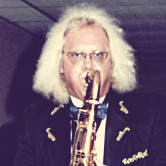Beginner’s Corner-IV
More Embouchure Questions
By Paul R. Coats
A student writes:
From all the books I have, I’ve always thought that the top teeth should rest on the mouthpiece. But today from a lot of people I read that you shouldn’t bite. Which one is correct?
Paul’s reply:
Both are! The lower lip controls the reed. The force necessary to do this is exerted through the lower lip with the muscles around the mouth, and this configuration is known as the “embouchure.” There are few muscles in the upper lip able to give the opposing force necessary to counter the rest of the embouchure. The upper teeth provide this opposing force on the top of the mouthpiece.
What saxophonists mean by telling you not to bite is that you should exert the force necessary to control the reed (or produce the A = 880 hz on the alto sax mouthpiece alone) with the embouchure muscles, those surrounding the mouth. You should NOT exert this force with the lower jaw pushing the bottom teeth through the lower lip. Both methods will control the reed, but the latter will HURT! And further, biting will damage the lower lip, perhaps permanently. You should NOT have a bleeding bottom lip from playing the saxophone!
The lower lip is compressed and supported from the sides and underneath by the muscles that come around the corners of the mouth and the flattened chin.
Do you have The Art Of Saxophone Playing? Every serious saxophonist should have this book. In there you will find a diagram of the muscles around the mouth.
Now let me explain some anatomy to you… a muscle can do two things, it can shorten, or it can relax. It is obvious that the lips can move from the relaxed position in two opposite directions… they can become wide open, as when you brush your front teeth, or they can purse down as if sucking from a straw. To open the lips wide there are muscles that radiate out from the lips like spokes of a bicycle wheel coming out from the hub. These muscles draw the lips out by shortening, but cannot push… remember, a muscle can only shorten or relax.
There is a circle of muscles that run around the lips. Imagine these muscles as being like a rubber band running around the mouth. They can shorten, and thereby close the lips, or they can relax. When they shorten, they draw the lips into a small circle. These are the muscles most used in the saxophone embouchure.
Place your thumb in your mouth with some of your bottom lip over the bottom teeth, and the pad of the thumb touching your upper teeth like the beak of the mouthpiece. Now, suck your thumb. Notice the lips naturally draw into a circle around the thumb.
For the saxophone, simply use the mouthpiece, and blow instead of suck. The position of the muscles is exactly the same. (Read a more thorough description of this in Beginner’s Corner Part III.)
Now, with the mouthpiece only, blow the A (matching the piano’s A) for alto sax, or the G just below that for tenor.
You may have to move the mouthpiece in or out a little to get a good, strong fortissimo tone. Once you can get this strong tone, and match the proper pitch, you are forming the correct embouchure.
Now, just use the same amount of embouchure tension when the mouthpiece is on the sax.
A further comment from the student:
I tried it on tenor sax and at first it sounded more like an A, so I lessened the pressure on the bottom lip and got it close to G. I thought maybe the reason I wasn’t getting out low notes was because my teeth were on top of the mouthpiece, but they come out easier now.
… and a few days later he wrote:
I figured out that I had to push the mouthpiece in and I put less lip over my lower teeth. Now I can go from low notes to high notes without moving my jaw. Thanks, you helped a lot.
Additional comment from Paul:
Yes, you must experiment with the amount of bottom lip to use, and how far to insert the mouthpiece. This is very difficult to describe to a student, but is easily found by having him blow the mouthpiece alone. The mouthpiece, without the huge resonating chamber of the saxophone attached, will not produce a full, strong tone unless all these conditions are met: (1) Correct embouchure tension, (2) Correct mouthpiece insertion, (3) Correct amount of lower lip over the teeth. Then the student is quickly on the way to better tone and intonation.


